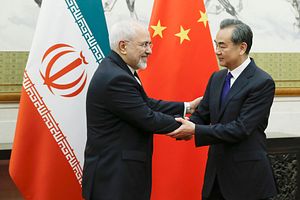It is no surprise that China is the first destination this week for Iranian Foreign Minister Mohamad Javad Zarif’s trip to shore up support for continued adherence to the Joint Comprehensive Plan of Action (JCPOA). As the U.S. withdrawal from the Iran deal brings all of Iran’s bilateral relationships around the world into focus, it is natural that Iran would check in first with the country that is currently its most consistent, reliable, and number one trading partner: China.
The largest communist country in the world and the largest theocracy in the world find common ground in trade, investment, and strategic interests that their fundamental political natures would seem to belie. China, however, sought influence in Iran long before the Iranian revolution of 1979. The Chinese Communist Party, according to diplomatic discussions and interviews with the Shah of Iran in the 1960s, may even have played a role in an assassination attempt on the Shah’s life — or so, at least, the Shah himself thought.
In a May 20, 1965 meeting with U.S. officials in Tehran, the Shah “expressed concerns over student activities…The Shah said that he had evidence that the recent attempt on his life [on April 10, 1965] was planned by students recently returned from England…Ambassador Holmes pointed out that there are indications of Chinese Communist influence among the students in Iran.”
On October 22, 1966, the U.S. ambassador to Iran, Armin Meyer, wrote a deeper diplomatic assessment of the role and influence that the Chinese Communist Party was having on Iranian students:
Savak [the Shah’s feared security services] is showing interest in long-term threat posed by the Chinese Communists. The latter have not been able to form any organization within Iran, but have been successful in their propaganda activities among Iranian students in Europe. An increasing number…have begun to show Communist Chinese sympathies and some of them apparently have even visited China. The Chinese have flooded Europe with publications which are having an effect on Iranian students some of whom can be expected to return to Iran and to attempt to conduct subversive activities. Savak believes that students returning…will have to be checked very carefully lest the Chinese Communists get a foothold in Iran. Although Savak believes that the pro-Soviet group now dominates the Tudeh party, it feels that the Chinese Communists, considering that they have been laboring under the double disadvantage of being newer in the field than the Soviets and of having no official representation in Iran, have done very well to date. …Savak will continue to observe closely the activities of Chinese Communist elements.
Ultimately, despite the Shah’s grave concerns of Chinese Communist influence not only in his own country, but throughout Southeast Asia, Pakistan, and elsewhere, the Shah’s Iran and China established normal and diplomatic ties in the 1970s. The warming relationship culminated in a state visit to Iran by Chinese Premier and Communist Party Chairman Hua Guofeng in 1978.
After the revolution, China recognized the new regime within days, a symbol of China’s willingness to continue to grow its influence in Iran despite a completely new political order run by religious extremists for whom China would normally have little tolerance. Although the new revolutionary government in Iran was slow to respond to the Chinese overtures, over time, the relationship grew, and today it is important to China and critical to Iran.
Today, Chinese and Iranian trade is based on everything from energy to arms, from nuclear technologies to Chinese infrastructure investment in Iran, from sunflowers to hijabs. China states that it will maintain its trading relationship with Iran, while at the same time fulfilling its “international obligations.”
Iranian nationals live in Yiwu, Zhejiang province, the largest small commodities wholesale market in the world, under special residency terms shared with a large population of other mostly Middle Eastern and Central Asian expatriates. Dedicated freight trains laden with containers full of Chinese exports go directly from Yiwu to Iran to support the trade link. Hotels in Yiwu are known to warn the rare visiting American to not disclose their nationality, in fear that the knowledge would incite Iranian guests to cause incidents, or worse.
China imports approximately 10 percent of its oil from Iran. It considers Iran to be a strategic partner in its Belt and Road Initiative. Minerals and natural resources on Iran’s side complement the financing and infrastructure projects which China provides.
And, of course, a steady stream of Iranian engineers has been in and out of China for decades, collaborating with the Chinese on chemical and nuclear technologies.
The China-Iran relationship, although beneficial for both sides, is nonetheless a curious one, particularly from the Iranian side, which is more ideologically motivated than the practical, transactional Chinese. It can be conjectured that while opposing communism, the mullahs, many of whom were imprisoned during the Shah’s tenure alongside members of the Communist Party of Iran, the Tudeh, may have sensed that a strategy rewarding the enemy of their enemy was in their interests. If the Shah’s instincts were right, and the Chinese Communist Party had influence in an attempt on his life, as well as in converting Iranian students to subvert the Shah’s rule, a discontent later leveraged by the mullahs, then from their point of view, a relationship with China for mutually opportunistic needs becomes possible.
The Shah is long gone, but the Chinese Communist Party is not. China has been able to translate its early efforts to influence Iranian students into its current position as Iran’s most important trading partner, and a strategic one for China’s own goals in the Middle East as a whole. Now, however, China must choose again and decide where its long-term interests really lie. Is it in protecting a regime with whom its closest ideological stance is probably a mutual dislike and distrust of the West, or is it with the modern world of nations committed to rule of law, protection of citizens’ rights, and peace and progress for humanity?

































